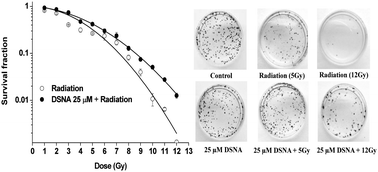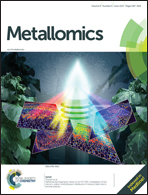Cellular evaluation of diselenonicotinamide (DSNA) as a radioprotector against cell death and DNA damage†
Abstract
Diselenonicotinamide (DSNA), a synthetic organoselenium compound, was evaluated for its radioprotective effect in cellular models. A clonogenic assay in Chinese Hamster Ovary (CHO) cells and an apoptosis assay in murine splenic lymphocytes indicated that pre-treatment with DSNA at a concentration of 25 μM significantly protected them from radiation-induced cell death. Upon irradiation (1–12 Gy), dose–response studies were carried out under similar treatment conditions, and its dose modification factor (DMF) was estimated to be 1.26. Furthermore, DSNA showed its radioprotective effect, even when administered after exposure to radiation. Mechanistic investigation revealed that DSNA increased the intracellular levels of GPx and GSH in irradiated cells. In line with this observation, the addition of a pharmacological inhibitor of GPx cycle, abrogated the activity of DSNA. The radioprotective effect of DSNA was also complemented by its ability to prevent radiation-induced DNA damage as monitored by micronucleus and γ-H2AX assays. Furthermore, treatment with DSNA did not show much change in the expressions of Nrf2 dependent genes (γ-GCL and HO-1), but the presence of a pharmacological inhibitor of Nrf2 abrogated the radioprotective activity of DSNA against cell death and DNA damage. Additionally, ATRA treatment also inhibited the DSNA-mediated up-regulation of a repair gene RAD51, suggesting possible involvement of basal Nrf2 in the anti-genotoxic effect of DSNA. In conclusion, the present study demonstrates radioprotection by a synthetic organoselenium compound containing nutritionally important moieties like selenium and nicotinamide.



 Please wait while we load your content...
Please wait while we load your content...